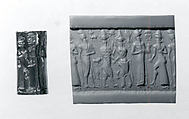Cylinder seal and modern impression: worshiper and the sun god; king; bull-man and a lion-man
Not on view
Although engraved stones had been used as early as the seventh millennium B.C. to stamp impressions in clay, the invention in the fourth millennium B.C. of carved cylinders that could be rolled over clay allowed the development of more complex seal designs. These cylinder seals, first used in Mesopotamia, served as a mark of ownership or identification. Seals were either impressed on lumps of clay that were used to close jars, doors, and baskets, or they were rolled onto clay tablets that recorded information about commercial or legal transactions. The seals were often made of precious stones. Protective properties may have been ascribed to both the material itself and the carved designs. Seals are important to the study of ancient Near Eastern art because many examples survive from every period and can, therefore, help to define chronological phases. Often preserving imagery no longer extant in any other medium, they serve as a visual chronicle of style and iconography.
The modern impression of the seal is shown so that the entire design can be seen. This seal shows a series of standing figures. A bearded male figure wearing a high domed headdress stands behind a wrestling lion-man and bull-man. A bearded worshipper offers a horned animal before a deity wearing a horned headdress. The deity holds a saw in his right hand, identifying him as Shamash, the sun god, who wields a saw to carve his passage through the eastern mountains every morning. A number of objects are arranged in the empty spaces of the pictorial field including a recumbent ram, walking bull, fish, turtle(?), fly, lion, and a grotesque frontal head identified as that of the demon Humbaba.
Due to rights restrictions, this image cannot be enlarged, viewed at full screen, or downloaded.

